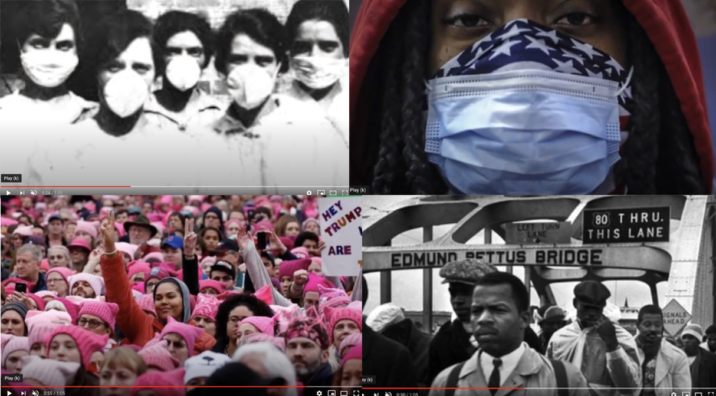
Image: Video stills: HIS 109 Fall 2020 / Professor Robin Morris, Agnes Scott College
After a removed summer of uncertainty about the fall teaching semester -- uncertainty about how to teach (in person or remote or a mixture of both?) and the weight of the urgency of stability of higher education in general, and at Agnes Scott in particular, all of which has been brought to the forefront because of the global pandemic, and the development of a police state in some of US cities, it was a relief to engage in a meeting with my colleagues to hear about and discuss new approaches to the virtual courses this fall.
Acutally, I found it inspiring. We don’t often get the pleasure of experiencing our peers teaching, and these short (two minute) vignettes were insightful into the varied creative approaches we all take tto relating to our students and relaying our expertise. As I said to everyone yesterday–I think we have an exciting opportunity right now to re engage how we think, learn and teach in the face of a new tool.
I was struck also at the use of inventive and persuasice imagery as we watched–Professor Robin Morris (ProRoMo–such a great twittter name!) made a video using historical and current footage of civil rights era iconic moments mixed in with 2020 video clips which she “treated” by using a style of image presentation that flattened the timeline (unless you know the images–which is her point, you DO know the images–you are unsure of weather this is today or fifty years ago) through creating it all in black and white, and with an affect of distressed film. So her treatment of the artifact was to further immerse the viewer in her point about HISTORY, which is her subject. The ultimate effect of the video leaves the viewer with an intellectual question: what’s going on. What a hook for teaching–I want to take the class, I want to talk about it. Leveraging the zoom media, she asked the viewers to engage the “chat box” by naming the images they recognized. It was hard NOT to participate. This was smart and exciting work–with IMAGERY.
Alan Grostephan by contrast, presented straightforward description–no screen share or visual assistance–of his intention to have the capstone writers work on an edited journal as an end product. His aim is that the journl will ultimately be submitted not to the class, but the world–via the world wide web. This is another isntance of what is surfacing as The Digital Humanities, a new genre in academia that takes advantage of the world wide information system known as the web, and opens up learning and audiences beyond the confines of our institution, and beyond the confines of higher education. These kinds of openings create free and open access to thinking and learning. Our knowledge creation becomes an open source informaiton system. The class itself becomes a generative teaching mechanism that ripples beyond the fall semester and has far reaching effect in time and place.
